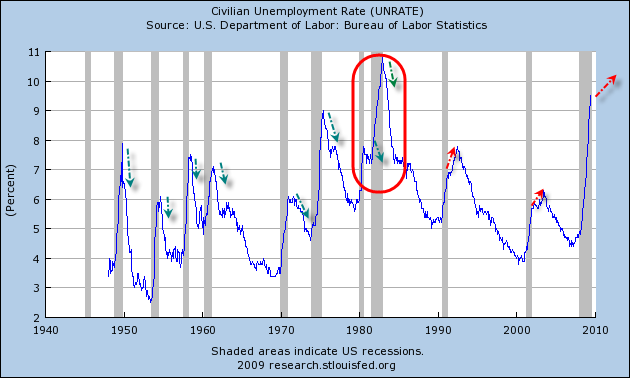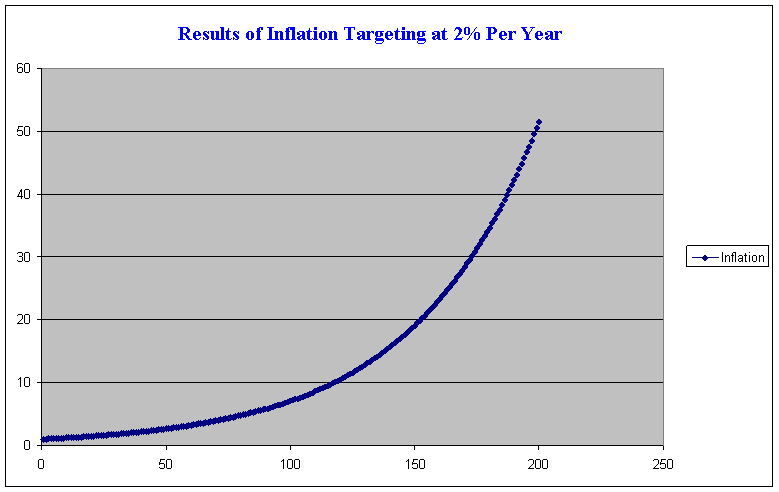Yellen Calls For "U" Shaped Recession and Another Jobless Economic Recovery
Economics / Recession 2008 - 2010 Sep 15, 2009 - 03:43 AM GMTBy: Mike_Shedlock
 One thing I like about Janet Yellen is that unlike Bernanke and Greenspan, she speaks understandable English and is not prone to sugar coating everything. I disagree with much of what she says, but not all of it.
One thing I like about Janet Yellen is that unlike Bernanke and Greenspan, she speaks understandable English and is not prone to sugar coating everything. I disagree with much of what she says, but not all of it.
Please consider these excerpts from Janet Yellen's Outlook for Recovery in the U.S. Economy.
Key Quotes
- As painful as this recession has been, I believe that we succeeded in avoiding the second Great Depression that seemed to be a real possibility.
- I regret to say that I expect the recovery to be tepid.
- Even if the economy grows as I expect, things won’t feel very good for some time to come. In particular, the unemployment rate will remain elevated for a few more years, meaning hardship for millions of workers.
- My own forecast envisions a far less robust recovery, one that would look more like the letter U than V. A large body of evidence supports this guarded outlook.
- Unfortunately, more credit losses are in store even as the economy improves and overall financial conditions ease.
- Certainly, households remain stressed. In the face of high and rising unemployment, delinquencies and foreclosures are showing no sign of turning around. Even recent-vintage loans are experiencing rising delinquency rates.
- The chances are slim for a robust rebound in consumer spending, which represents around 70 percent of economic activity. Consumers are getting a boost from the fiscal stimulus package. But this program is temporary.
- It may well be that we are witnessing the start of a new era for consumers following the traumatic financial blows they have endured. While certainly sensible from the standpoint of individual households, this retreat from debt-fueled consumption could reduce the growth rate of consumer spending for years.
- My business contacts indicate that they will be very reluctant to hire again until they see clear evidence of a sustained recovery, and that suggests we could see another so-called jobless recovery in which employment growth lags the improvement in overall output.
Additional Highlights
Normally, if credit flows were restricted by these types of financial headwinds, the Fed would ease the stance of monetary policy by cutting its federal funds rate target. But the funds rate is already at zero for all practical purposes, leaving the Fed’s traditional policy tool as accommodative as it can be.
Many versions of the Taylor rule, a well-known policy benchmark based on the state of the economy and inflation, indicate that we should lower the funds rate well below this zero bound—if such a thing were possible.
This brings me to the complex topic of inflation. In my career, I have never witnessed a situation like the one that exists now, when views about inflation risks have coalesced into two diametrically opposed camps. On the one hand, one group worries about the long-term inflationary implications of a seemingly endless procession of massive federal budget deficits. At the same time, others fear that economic slack and downward wage pressure are pushing inflation below rates that are considered consistent with price stability and even raising the specter of outright deflation.
This dichotomy is on display among the participants in the Survey of Professional Forecasters. The lowest quartile of forecasters focuses on disinflation over the next five years. The top quartile is preoccupied with the possibility of rising inflation five to ten years out.
My personal belief is that the more significant threat to price stability over the next several years stems from the disinflationary forces unleashed by the enormous slack in the economy.
Today, we are starting with very low inflation. Core PCE price inflation has averaged just under 1½ percent over the past twelve months, which is already below the 2 percent rate that I and most of my FOMC colleagues consider an appropriate long-term price stability objective. With slack likely to persist for years, it seems likely that core inflation will move even lower, departing yet farther from our price stability objective.
From a monetary policy point of view, the landscape will continue to present challenges. We face an economy with substantial slack, prospects for only moderate growth, and low and declining inflation. With our policy rate already as low as it can go, it’s no wonder that the FOMC’s last statement indicated that “economic conditions are likely to warrant exceptionally low levels of the federal funds rate for an extended period.”
I can assure you that we will be ready, willing, and able to tighten policy when it’s necessary to maintain price stability. But, until that time comes, we need to defend our price stability goal on the low side and promote full employment. Thank you very much.
It's a long speech, well worth a read in entirety. Unlike much of the undeserved praise Bernanke heaps upon himself (See Orwellian Madness "Bernanke Saved The World"), Yellen's speech appears to be genuine.
Moreover, Yellen does not sugar coat the grim jobs picture or the credit problems that lay ahead. Indeed what she is describing seem more like an L-Shaped recession than a "U". In contrast, I often wonder if Bernanke really believes what he is saying or if he is simply trying to absolve himself of blame just as Greenspan does.
On April 8, 2008 I made the Case for an "L" Shaped Recession and I do not see any reason to change that stance.
Certainly the recession has already gone on longer than most thought. Although we are coming out of recession now, it's important to note Yellen is calling for "another so-called jobless recovery".
Well, a jobless recovery when unemployment is at 5% is one thing, a jobless recovery is another thing indeed when the rate is 10-11%.
For more on jobless recoveries please see Dismal Unemployment Situation In Chart Form.
Here is one of the charts from the article.
Job Loss Recovery

No Driver For Jobs
In the 1980's and 1990's an internet boom created massive numbers of jobs. Between 2000 and 2007 a housing boom created massive numbers of jobs. I keep asking what the next driver for jobs will be. Inventory replenishment will not do it. Nor will one-time stimulus efforts like road building.
Nothing on the energy front seems capable at this time of producing such a boom. Commercial real estate is massively overbuilt as is the retail sector. So don't look for Home Depot (HD), Lowes (LOW), Target (TGT), or Walmart (WMT) to lead the way. Forget about banking too as Citigroup (C), Wells Fargo (WFC), and Bank of America (BAC) have their hands full and then some.
And although one can never tell in advance when technology breakthroughs will happen, as we have seen, internment booms are not that common. In 2001 everyone was waiting for the next "killer app". Everyone is is still waiting so don't look at Intel (INTC), Microsoft (MSFT), or the technology sector either.
So while everyone is tooting horns and cheering the end of the end of the recession before it has even ended, those graphs and comments from Bernanke himself will put the pending job loss Recovery into better perspective.
Yellen Supports Inflation Targeting
My biggest gripe with Janet Yellen (aside the fact that the Fed should not exist at all) is her support of inflation targeting. Since when is a 2% annual rise in prices stable? Here is a chart that shows what I mean.
Inflation Targeting at 2% a Year

Eventually, on such an insane scheme, wages are bound to not keep up with prices. Moreover, the Fed ignores asset bubbles in its calculation of "inflation".
Finally it is far beyond silly to think the fed can control prices in the first place. The last four years should be proof enough.
Thus, not a single person who is thinking clearly believes Yellen when she says "I can assure you that we will be ready, willing, and able to tighten policy when it’s necessary to maintain price stability. But, until that time comes, we need to defend our price stability goal on the low side and promote full employment. Thank you very much."
Janet Yellen does not know price stability from asteroids, and even if she did, the Fed has proven it will not act on asset bubbles. Moreover, the Fed has proven it cannot control prices even if it wanted to.
Yet, amazingly Belief In Wizards Runs Deep.
Inflation Targeting and Price Stability Questions
- Why should inflation be targeted at 2% and not 1% or 3%?
- Why should any inflation be targeted at all?
- Even if it was smart to target prices, can prices really be measured it accurately?
- What do central banks do to overcome lag effects of monetary tightening and loosening?
- Is this just blind faith "we know neutral when we see it"?
For more on the total ridiculousness of Fed promoted price stability please see the Fallacy of Inflation Targeting.
That the Fed ignored asset prices in its measure of "inflation" is one of the reasons we are in this mess.
Correct Inflation Target Is Zero
Here's the deal. The correct inflation target is zero. And we will never get there with a bunch of Fed clowns who think micromanaging interest rates is the way to achieve stability.
Inquiring minds are reading Does Inflation Targeting Make Any Sense?
Volcker: "I don't get it," ... By setting 2% as an inflation objective, the Fed is "telling people in a generation they're going to be losing half their purchasing power."
Inflation Targeting Is A Moral Hazard
Given that inflation benefits those with first access to money, any targeted inflation at all is morally wrong. Finally, for all this silly talk about inflation fighting and inflation targeting, it's important to remember what inflation really is. Inflation is an expansion of money supply and credit, where credit is marked to market. Prices generally follow money supply but there is a variable time lag, productivity and consumer sentiment are huge factors, as are a host a host of global factors including interest rate differentials and currency fluctuations.
So even if the Fed could achieve that magic 2%, the whole shebang would eventually blow sky high anyway (as it just did) because wages will not keep up with prices causing asset bubbles to pop.
By Mike "Mish" Shedlock
http://globaleconomicanalysis.blogspot.com
Click Here To Scroll Thru My Recent Post List
Mike Shedlock / Mish is a registered investment advisor representative for SitkaPacific Capital Management . Sitka Pacific is an asset management firm whose goal is strong performance and low volatility, regardless of market direction.
Visit Sitka Pacific's Account Management Page to learn more about wealth management and capital preservation strategies of Sitka Pacific.
I do weekly podcasts every Thursday on HoweStreet and a brief 7 minute segment on Saturday on CKNW AM 980 in Vancouver.
When not writing about stocks or the economy I spends a great deal of time on photography and in the garden. I have over 80 magazine and book cover credits. Some of my Wisconsin and gardening images can be seen at MichaelShedlock.com .
© 2009 Mike Shedlock, All Rights Reserved
Mike Shedlock Archive |
© 2005-2022 http://www.MarketOracle.co.uk - The Market Oracle is a FREE Daily Financial Markets Analysis & Forecasting online publication.



